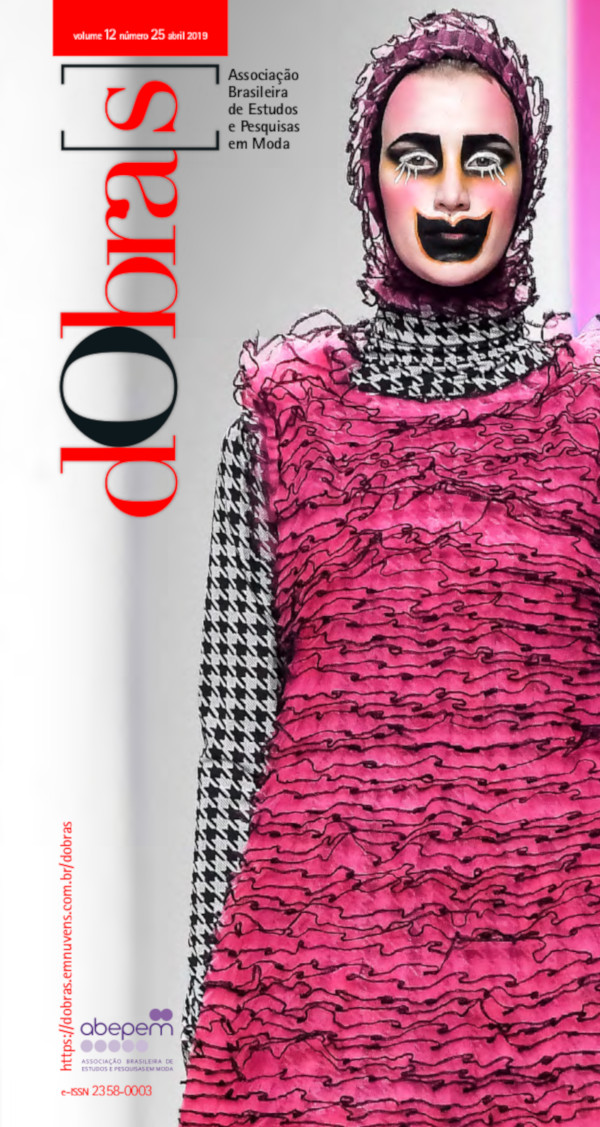The corset and the veil as disruptive manifestations of clothing: the tightlacer and the Tuareg
DOI:
https://doi.org/10.26563/dobras.v11i25.853Schlagworte:
corset, veil, tightlacing, Tuareg, semiotics.Abstract
This work investigates two items of clothing and the relations constructed between their fashionable and disruptive manifestations: the Corset and the Veil. Examining the societies which are emblematic of those practices – the Victorian Era and the Tuareg, from Northern Africa – the works of Greimas and Landowski will provide a framework for a Semiotic and Socio-semiotic analysis of the practices of tightlacing and male veiling as opposing practices to traditional gender roles. Even though the two practices forming the corpus of this work are geographically and chronologically distant, our analysis forms a parallel between them, exposing how the mechanism of Otherness through clothing occurs similarly at different times and locations, as well as the importance of Fashion in creating and sustaining prevalent ideologies.
Downloads
Literaturhinweise
HALEEM, M. A. S. The Qur’an. A new translation by M. A. S. Abdel Haleem. Oxford: Oxford University Press, 2011.
AHMED, Leila. Women and the advent of Islam. Signs. Chicago, v. 11, n. 4, p. 665-691, Summer 1986. DOI: https://doi.org/10.1086/494271
BARTHES, Roland. The Language of Fashion. Oxford: Berg, 2006.
BARTHES, Roland. Mythologies. London: Vintage, 2009.
BAUDELAIRE, Charles. The Painter of Modern Life and Other Essays. London: Phaidon, 1964.
DUVEYRIER, Henri. Les Touareg Du Nord. Exploration du Sahara. Paris: Challamel Aîné, 1864.
FIORIN, José Luiz. À propos des concepts de débrayage et d’embrayage: les rapports entre la sémiotique et la linguistique. Actes Sémiotiques, Limoges, n. 119, February 2016. Available at: http://epublications.unilim.fr/revues/as/5605 Accessed in: 10th March 2019. DOI: https://doi.org/10.25965/as.5605
FLOCH, Jean-Marie. Sémiotique, marketing et communication. Sous les signes, les stratégies. Paris: PUF, 1990.
FOUCAULT, Michel. História da Sexualidade. A vontade de saber. São Paulo: Graal, 2012. v. 1.
FOUCAULT, Michel. História da Sexualidade. O uso dos prazeres. São Paulo: Graal, 2012a. v. 2.
FREUD, Sigmund. O Inquietante. Obras Completas. São Paulo: Companhia das Letras, 2010. p. 329-376. v. 14.
GIDDENS, Anthony. The Transformation in the Intimacy. Sexuality, Love & Eroticism in Modern Societies. Cambridge: Polity Press, 1993. DOI: https://doi.org/10.1086/230354
GREIMAS, Algirdas Julien. Da imperfeição. São Paulo: Hacker, 2002.
GREIMAS, Algirdas Julien; COURTÉS, Joseph. Dictionnaire raisonné de la théorie du langage. Paris: Hachette, 1993.
JARDIM, Marilia. O Corset na Moda Ocidental. 2014. Dissertação (Mestrado em Comunicação e Semiótica) – Programa de Pós-Graduação em Comunicação e Semiótica, Pontifícia Universidade Católica de São Paulo, São Paulo, 2014.
KEENAN, Jeremy. The Lesser Gods of the Sahara. Social Changes and Contested Terrain amongst the Tuareg of Algeria. London and Portland: Frank Cass, 2004.
KUNZLE, David. Fashion and Fetishism. Corsets, tight-lacing & other forms of body-sculpture. Stroud: Sutton, 2004.
LANDOWSKI, Eric. Passions sans nom. Paris: PUF, 2004.
LANDOWSKI, Eric. Les interactions risquées. Limoges: PULIM, 2005.
LANDOWSKI, Eric. Avoir prise, donner prise. Actes Sémiotiques, Limoges, n. 112, 2009. Available at: http://epublications.unilim.fr/revues/as/2852. Accessed in: 10th March 2019. DOI: https://doi.org/10.25965/as.2852
LECOCQ, Jean Sebastian. Disputed Desert. Decolonisation, Competing Nationalisms and Tuareg Rebellions in Northern Mali. Leiden, Boston: Brill, 2010. DOI: https://doi.org/10.1163/ej.9789004139831.i-433
LYNN, Eleri. Underwear Fashion in Detail. London: V&A, 2010.
MURPHY, Robert F. Social distance and the veil. American Anthropologist, Arlington, v. 66, n. 6, Part 1, p. 1257-1274, December 1964. DOI: https://doi.org/10.1525/aa.1964.66.6.02a00020
RICHARDS, Melissa. Anti-fashion and Punk Couture. Key Moments in Fashion. London: Hamlyn, 1999. p. 144-155.
SAID, Edward. Orientalism. London: Penguin, 2003.










